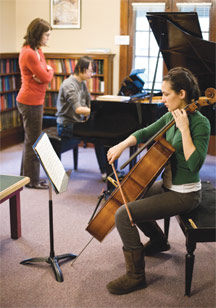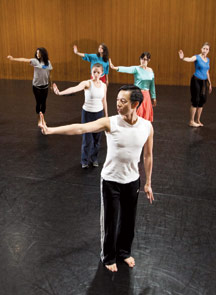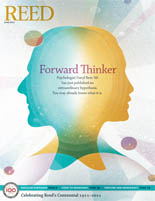
IRIS login | Reed College home Volume 90, No. 2: June 2011
Centennial Campaign
Rhapsody In Brick (continued)

Mellow Cello? New soundproofed practice rooms will replace the distracting cacophony of Prexy.

Stop! In the name of love . . . a dedicated dance studio will benefit instruction in a discipline that currently shares space with the P.E. department. Here, professor Minh Tran leads a dance class in a sports center gym.
Scholarship and the performing arts
Reed has always maintained a strong commitment to active learning. Students don’t just read scholarship; they have to be scholars, creating a thesis from primary source material.
Rachel Carnes ’93 was a dance/theatre major who went on to found a nonprofit based in Eugene that uses dance to develop social, emotional, and cognitive intelligence.
“My teachers at Reed—and the curriculum they developed—enabled me to see that the performing arts could, and should, be integrated into every other field of study,” she says. “Now I use dance to teach non-dancers about how their brains work. I use theatre to teach non-performers how to get kids excited about math, science, and reading. I simply want every kid, every student, to have the chance to learn the way I did. When I was a younger person, I didn’t think of my time rehearsing on stage or working in the studio as ‘inquiry.’ But in retrospect, I realize that few opportunities in life have tested my critical thinking skills more thoroughly, or more enjoyably than Dance 210.”
“There is a Reed approach across the board and it’s there in theatre,” adds Finocchiaro. “Each department translates that approach differently, but the general approach is the same: creating well-rounded, thoughtful students that know how to think on their feet, know how to analyze and actually be aware of what they’re doing, whatever that is.”
While he never considered himself a hands-on person, he ended up becoming the master electrician for the department for two years.
“You can’t come in here and say, ‘I’m an actor,’ because you’re going to do everything. You’re going to learn things you didn’t think you were able to learn, be good at, or ever wanted to do. I never thought I would be an electrician, hanging lights and building platforms. But I have more confidence on a general level because of those skills the department taught me.”
Finocchiaro’s thesis, Shooting History in the Neck, explores the ways in which American avant-garde theatre directors deconstruct and explode both history and historical personalities.
A graduate of Reed should have a strong sense of the skills needed in the performing arts, according to Worley. The performing arts require a commitment to a choice to see where it leads as well as collaboration with others, including the audience.
“The liberal arts are wonderful in that they allow you to make multiple suppositions and to explore possibilities in an intellectual way,” Worley says. “You can hypothesize anything about a piece of literature and write about it, and there’s no particular consequence for that, except that you enrich your mind with the juggling of possibilities. But if you’re doing a production of A Doll’s House, you have to make a whole bunch of choices and you will find out the consequences of those choices. Our lives are filled with situations in which we have to make choices and live with the consequences of those choices. The practice of art teaches something about that.”
“Dance can at once be evocative, referential, and abstract,” says professor Carla Mann ’81 [dance 1995–]. “For me, that seems to be a really potent area for generating critical thinking and analysis. We often think of the activities of critical analysis as being reading and writing and speaking. But they could also be moving, making, and seeing. Dance really brings those activities together in a way that not only articulates ideas, but embodies them.”
The goal of the new building is to promote more collaboration—both planned and spontaneous—among students, faculty, and departments, and its placement on the quad will reinforce the visibility of the performing arts at Reed. The sciences, long grouped in buildings on the east end of the campus, will be finally balanced by the performing arts on the west, giving students in all disciplines the opportunity to explore innumerable pathways that lead in new and unexpected directions.
At a Glance:
Performing Arts Building
- 450-seat Proscenium Theatre. (Phase III).
- 180-seat Studio Theatre with movable seating platforms.
- 99-seat Black Box Theatre with a barn door that opens to the lobby.
- Dance studio with sprung wood floor.
- Theatre/dance rehearsal room.
- Music/choir rehearsal room.
- Winter Garden lobby with radiantly heated and chilled concrete floors and natural ventilation.
- Rooftop garden for gatherings and functions.
- Classrooms, practice rooms, technology center, multimedia library, scene studio, costume studio, and offices.
- Bioswales and rain gardens cleanse all onsite rainwater with zero discharge to city’s storm water system.
- Windows and skylights reduce dependence on artificial light and provide better options for teaching and learning.
- New public entry on the west edge of campus.
- Previous Page
- 1
- 2
- 3
- Next Page


LATEST COMMENTS
steve-jobs-1976 I knew Steve Jobs when he was on the second floor of Quincy. (Fall...
Utnapishtim - 2 weeks ago
Prof. Mason Drukman [political science 1964–70] This is gold, pure gold. God bless, Prof. Drukman.
puredog - 1 month ago
virginia-davis-1965 Such a good friend & compatriot in the day of Satyricon...
czarchasm - 4 months ago
John Peara Baba 1990 John died of a broken heart from losing his mom and then his...
kodachrome - 7 months ago
Carol Sawyer 1962 Who wrote this obit? I'm writing something about Carol Sawyer...
MsLaurie Pepper - 8 months ago
William W. Wissman MAT 1969 ...and THREE sisters. Sabra, the oldest, Mary, the middle, and...
riclf - 10 months ago